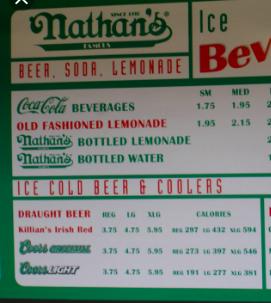As of May last year, all American restaurant chains with 20 or more outlets have been legally obliged to provide calorie counts on their menus in a bid to help people make less fattening choices. So how's that going then?
Not so well if the latest study – the largest to date on how calorie information affects consumer purchases – is anything to go by.
The setting for the study, published in the British Medical Journal was a large franchise of a national fast-food company with three different restaurant chains located in Louisiana, Texas, and Mississippi (you can do the sleuthing and come up with some theories as to who this might be, but the franchisees who handed over data didn’t get active permission from head office to name the restaurant, so the authors couldn’t divulge).
104 outlets were involved in the analysis, all of which added calorie information to their in-store and drive-thru menus in April 2017. Weekly aggregated sales data was made available to the researchers from the pre-labeling (April 2015 to April 2017) period to up until April 2018 – a year after labeling implementation. That’s a whole lot of data – around 50 million transactions – and a far longer follow-up than most previous evaluations of food labeling interventions.
Virtually no impact…
Unfortunately, the study results make uncomfortable reading for public health policymakers who have pushed to make calorie labeling mandatory. The investigators found that calorie labeling produced an immediate decrease of 60 calories per transaction or 4% of total calories purchased (which was not due to menu reformulation). But over the following year, that 60 calorie reduction had attenuated to just 23 fewer calories for each purchase made, or just 10 fewer calories if only one rather than two years of pre-implementation data was used in crunching the stats.
Either way, it’s a pretty meaningless reduction in calorie intake.
Drink consumption fell
Further analysis by the authors showed that the initial drop in calories was more related to buying fewer items, like sides than not choosing lower-calorie options. Over time more familiar food purchasing habits returned.
As if to highlight exactly how unpredictable purchasing habits at point-of-source can be, soft drinks were one purchase that went down and didn’t bounce back. It wasn’t just sugary drink purchases that dropped – to 61% of the pre-labeling sales – but also sales of sugar-free drinks, to only 47% of pre-labeling sales.
It isn’t possible to interpret why: were incentives to add drinks to meal choices altered, was there a change in customer habits (like more drive-thru custom with fewer drinks being purchased for fear of spillage), or were customers simply less thirsty?
Yes, takeout contain A LOT of calories
One thing this study highlights is that fast food – whatever type this was – contains a crap ton of calories. The average calorie content per purchase was nearly 1500 kcals, so three-quarters of the average daily calorie goal of 2000 kcals per day. To be fair the authors had no way of checking whether a purchase was for single or shared consumption, though that’s still a lot even if you’re sharing it with a buddy.
Perhaps the fact that simple point-of-sale calorie labeling has little influence on altering takeout buying habits isn’t such a surprise at all. If you were a dieter trying to lose weight you’d probably avoid the temptation of these places altogether. And if not, and you’re in the mood for a blowout, you may not be influenced to change your favorite gut-busting choice just because the calorie count looks a touch hairy.
Looking for a silver lining
It’s also possible that in this mass of heterogeneous data, there were some small pockets of people who did make significantly lower-calorie choices post-calorie-labeling, but many more who just didn’t bother at all.
Of course, calorie labeling might not be a complete waste if it means restaurants are keener to reformulate their offerings. And if the menu makes it clear you ate a 1500 calorie lunch, you might just make a slightly bigger effort to reign things in at dinner.
An accompanying editorial to the paper in the BMJ also puts forward the case that even these tiny changes to calorie intake might have meaningful effects at the population level.
But these do all seem rather like clutching at straws in the face of something that is not very certain -– having calorie intakes writ large on the menu is not going to solve the obesity crisis.
It’s been said before and you'll hear it again: obesity is a complex condition and there are no silver bullets. It needs a whole suite of measures to help tackle it, as well as an understanding that eating takeout often is a bad idea.




